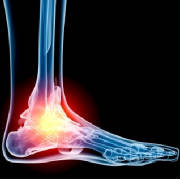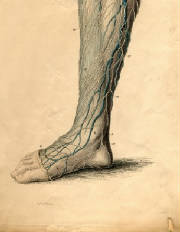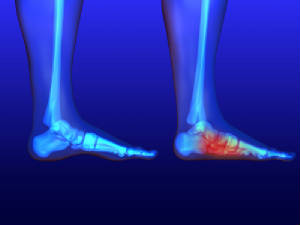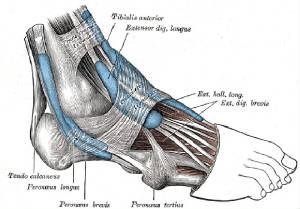|
Tuesday, June 24, 2014
Woman With Rheumatoid Arthritis Competes in 5K Marathons Mary Kaufman has struggled with the painful effects of Rheumatoid Arthritis (RA) for twenty years. Despite suffering from what can be incredibly debilitating, Kaufman still manages
to keep a healthy, active lifestyle, including partaking in 5K runs. Mary Kaufman has struggled with the painful effects of Rheumatoid Arthritis (RA) for twenty years. Despite suffering from what can be incredibly debilitating, Kaufman still manages
to keep a healthy, active lifestyle, including partaking in 5K runs.
Even
though she still maintains a positive lifestyle, Kaufman still does experience her share of challenges as a result of her
condition. For example, RA still renders Kaufman susceptible to sustaining stress fractures. Fortunately, a combination
of a considerable amount of training and medication has allowed Kaufman to strengthen her lower extremities. Kaufman has
competed in two races last year and aspires to double the amount this year. Ultimately, Kaufman wishes to be an inspiration
for others suffering from RA. Rheumatoid arthritis is a difficult condition
to live with. If you suffer from the painful effects of rheumatoid arthritis, see podiatrist Dr. Karin Johansson, DPM of New York. Dr. Johansson can treat your foot and ankle related needs. What
Is Rheumatoid Arthritis? Rheumatoid Arthritis (RA) is an autoimmune
disorder in which the body’s own immune system attacks the membranes surrounding the joints. Inflammation of the lining
and eventually the destruction of the joint’s cartilage and bone occurs, causing severe pain and immobility. Rheumatoid Arthritis of the Feet Although RA usually attacks multiple bones and joints throughout the entire body, almost 90 percent of cases result
in pain in the foot or ankle area. Pain often initially presents in the toes before the condition worsens and spreads throughout
the entire foot. Rheumatoid arthritis appears to be genetically inherited, so if you have a family history of RA, you may
be predisposed to suffer from it as well. Symptoms - Swelling & pain in the feet
- Stiffness in the feet
- Pain on
the ball or sole of feet
- Joint shift and deformation Diagnosis
Quick diagnosis of RA in the feet is important so that the podiatrist
can treat the area effectively. Your doctor will ask you about your medical history, occupation, and lifestyle to determine
the origin of the condition. For more information about Rheumatoid Arthritis,
follow the link below. If you have any questions, please contact our office
located in New York, NY. We offer the newest diagnostic and treatment technologies for all your foot care needs. Read more about Rheumatoid Arthritis
Friday, June 20, 2014
Uncommon Disorder Known to Cause Neuropathy Eighteen months ago, Hartford resident Serena Clarkson was diagnosed with Charcot-Marie-Tooth disorder, and now wears an ankle-foot orthotic. Clarkson underwent six surgeries in her right leg over a single day. “Even
with the AFO I’m up to 2,249 feet a day and that’s it,” Clarkson said, “that’s all I can walk.
I have an ankle stabilizer I wear on the left leg, and I’m pending surgery on that one.” Eighteen months ago, Hartford resident Serena Clarkson was diagnosed with Charcot-Marie-Tooth disorder, and now wears an ankle-foot orthotic. Clarkson underwent six surgeries in her right leg over a single day. “Even
with the AFO I’m up to 2,249 feet a day and that’s it,” Clarkson said, “that’s all I can walk.
I have an ankle stabilizer I wear on the left leg, and I’m pending surgery on that one.”
About
2.5 million Americans suffer from this disorder, with 60 percent of these cases being type 1. Signs of CFT include hammertoes
and high arches.
Nerve disorders can be a debilitating experience. If you are struggling with a foot or ankle condition, see podiatrist Dr. Karin Johansson, DPM of New York. Dr. Johansson can treat your foot and ankle needs.
Nerve Disorders of the Foot and Ankle
There are two nerve disorders of the foot and ankle called Interdigital Neuroma and Tarsal
Tunnel Syndrome. These conditions affect the hands as well, and are caused by stress and genetics. People who suffer from
Interdigital Neuroma and Tarsal Tunnel Syndrome are prone to serious pain and inflammation in the area.
Pain that is associated with Interdigital Neuroma is often from local inflammation in the nerves in the
front of the foot. Symptoms include pain, burning, and/or tingling sensations of the toes.
There are several steps a doctor will take to determine if one has Neuroma such as: radiographs, MRIs, and bone scans.
Surgery is not required in many instances, and should only be considered when the patient is suffering from persistent pain.
Tarsal Tunnel Syndrome is a condition that is less common than Interdigital Neuroma.
It only seems to affect patients who have severe ankle pain which begins in the bottom of the foot extending all the way
to the calf. In other instances one may encounter partial numbness and atrophy if the cases are extreme.
EMG tests are often provided to diagnose Tarsal Tunnel Syndrome. If a patient shows signs of Tarsal
Tunnel Syndrom, an MRI will be used to see the compression of the nerve. As always, if symptoms do persist, surgery may
be required.
If you have any questions, please contact our office
located in New York, NY. We offer the newest diagnostic and treatment technologies for all your foot care needs. Read the Full Article on Nerve Disorders of the Foot and Ankle.
Tuesday, June 10, 2014
Minor Foot Injury Said to Not Affect Soccer Star  Brazilian footballer Neymar, one of Team Barcelona’s players,
issued a troubling statement that may affect his game in the coming World Cup. After his first season in Spain with his team,
Neymar says that he sustained a foot injury. However, Neymar asserts that his injury is relatively minor and will not affect
his performance. Brazilian footballer Neymar, one of Team Barcelona’s players,
issued a troubling statement that may affect his game in the coming World Cup. After his first season in Spain with his team,
Neymar says that he sustained a foot injury. However, Neymar asserts that his injury is relatively minor and will not affect
his performance. "It's swollen because it's not returned
to what it was, but the foot is fine. Physically I'm 100%. It was a year of learning. It was not the year I thought it would
be, I imagined winning titles and making millions of goals, but that's not how things work. Do not say it was a bad year."
Neymar told Globo TV reporters. A sports related foot or ankle injury can happen even to athletic
superstars. If your foot or ankle was injured, see podiatrist Dr. Karin Johansson, DPM of New York. Dr. Johansson can treat your foot and ankle injuries. Sport Related Foot and Ankle Injuries Foot and ankle injuries are a common occurrence when it comes to athletes of any sport. While many athletes dismiss
the initial aches and pains, the truth is that ignoring potential foot and ankle injuries can lead to serious problems. As
athletes continue to place pressure and strain the area further, a mild injury can turn into something as serious as a rupture
and may lead to a permanent disability. There are many factors that contribute to sports related foot and ankle injuries,
which include failure to warm up properly, not providing support or wearing bad footwear. Common injuries and conditions athletes
face, including: •
Plantar Fasciitis •
Plantar Fasciosis •
Achilles Tendinitis •
Achilles Tendon Rupture •
Ankle Sprains Sports-related
injuries are commonly treated using the RICE method. This includes rest, applying ice to the injured area, compression and
elevating the ankle. More serious sprains and injuries may require surgery, which could include arthroscopic and reconstructive
surgery. Rehabilitation and therapy may also be required in order to get any recovering athlete to become fully functional
again. Any unusual aches and pains an athlete sustains must be evaluated by a licensed, reputable medical professional.
If you have any questions, please contact our office
located in New York, NY. We offer the newest diagnostic and treatment technologies for all your foot care needs. Read more about Sports Related Foot and Ankle Injuries.
Thursday, June 5, 2014
Tarsal Tunnel Syndrome Can Be Recognized According to physical therapist Steve Miller, Tarsal Tunnel Syndrome is a common condition. Miller says that the ailment is prevalent among people with flat feet or
who partake in intense physical activity unprepared. According to physical therapist Steve Miller, Tarsal Tunnel Syndrome is a common condition. Miller says that the ailment is prevalent among people with flat feet or
who partake in intense physical activity unprepared.
Tarsal Tunnel Syndrome is named for the compression on the tibial nerve in the ankle. The compression causes a shooting pain
in the foot, ankle and lower leg. To help ease the pain, a physician can provide soft tissue massages and nerve glides to
lessen the pressure being placed on the tibial nerve. Tarsal tunnel
syndrome is a serious condition. If you have pain in your foot or ankle, see podiatrist Dr. Karin Johansson, DPM of New York. Dr. Johansson can treat your foot and ankle needs. Tarsal Tunnel
Syndrome
Tarsal tunnel syndrome, which can also be called tibial nerve dysfunction,
is an uncommon condition of misfiring peripheral nerves in the foot. The tibial nerve is the peripheral nerve in the leg
responsible for sensation and movement of the foot and calf muscles. In tarsal tunnel syndrome, the tibial nerve is damaged,
causing problems with movement and feeling in the foot of the affected leg.
Common Cause of Tarsal Tunnel Syndrome
-Involves pressure
or an injury, direct pressure on the tibial nerve for an extended period of time, sometimes caused by other body structures
close by or near the knee.
-Diseases that damage nerves, including diabetes, may cause tarsal tunnel syndrome.
-At times, tarsal tunnel syndrome can appear without an obvious cause in some cases. The Effects of Tarsal Tunnel Syndrome
-Different sensations,
an afflicted person may experience pain, tingling, burning or other unusual sensations in the foot of the affected leg.
-The foot muscles, toes and ankle become weaker, and curling your toes or flexing your foot can become difficult.
-If condition worsens, infections and ulcers may develop on the foot that is experiencing the syndrome.
A physical
exam of the leg can help identify the presence of tarsal tunnel syndrome. For
more information about Tarsal Tunnel Syndrome, follow the link below. If
you have any questions, please contact our office located in New York, NY. We offer the newest diagnostic and treatment technologies for all your foot care needs. Read more about Tarsal Tunnel Syndrome
|